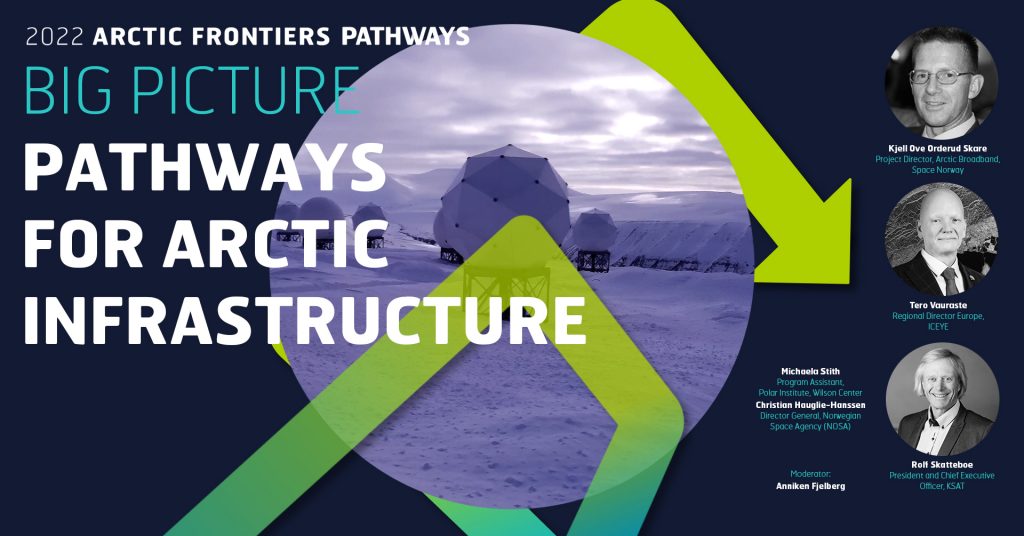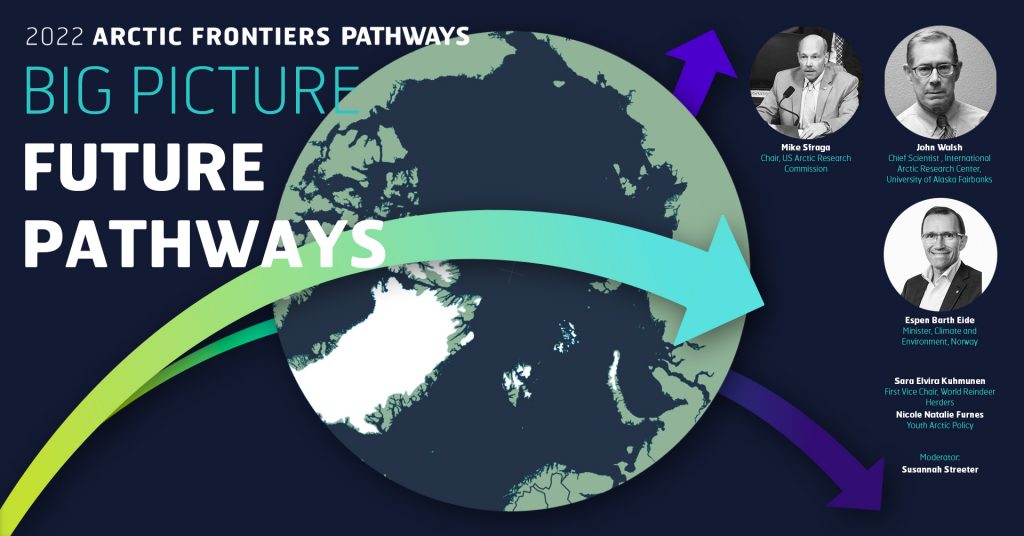
The theme of the 2022 Arctic Frontiers conference was Pathways. The conference had five Big Picture sessions, high-level discussions that combined expertise within science, policy and business to address the most pressing issues facing the Arctic Region. Read more about the sessions here:
All the sessions were recorded and are available on our YouTube channel:
Arctic Collaboration: Pathways Forward
Arctic exceptionalism is at play and the framework for Arctic collaboration is upended because of the actions of one Arctic nation, outside of the Arctic region. As concerns related to hard as well as soft security and the division between international, national, regional, and local interests dominate the discussions, how can we carve a pathway forward? Whatarethe Arctic preparedness plans in this rapidly changing landscape? Is multilateralism still our preferred path facing the global future challenges which are also applicable in the Arctic? Can we balance sustainable development in the Arctic if we don’t have a common vision for the region and the international Arctic collaboration as we know it has been paused?
This high-level session sought to discuss the effects of the war in Ukraine on the Arctic collaboration, the
potential structures for renewed collaboration, and the impact of global development trends on the Arctic. Can the region find its way back on the track of cooperation, stable management, and sustainable development, and what are the alternative structures?


Pathways to Sustainable Use of the Ocean
It is no secret that we need our oceans to meet growing demands for food and resources.Climate
changepushes changes also in the ocean, increasing unpredictability. This session focused on the use
of the ocean in the light of climate change which challenges our current understanding, the rapid growth of ocean-based industry and need to balance it with the sustainability of the ocean.
How can innovation in business operations and technology ensure the sustainability of the blue
economy? Can the use of artificial intelligence help make predictions? Will these new developments stimulate new ocean-based business? How can blue economy contribute to feeding the growing population of the planet and at the same time be one of the driving forces for green transition? How do we do more with less? What kind of impact will blue economy have on the Arctic communities?Researchers, policymakers and representatives from the business community will share their perspectives on the recent developments, discuss coexistence and the opportunities to come.
Pathways to Sustainable Finance
Countries all over the world have used fiscal stimulus packages in response to the Covid-19 economic crises to further promote policies linked to environmentally sustainable growth, a tendency observed already before the outbreak of the pandemic. One of the tools in this building-back-better tool kit is the European Union’s taxonomy for sustainable activities which will affect companies well beyond European borders.
The Arctic is a region with abundant renewable energy options with a long track record on sustainable industrial development. But the Arctic is also diverse, characterized by unequal levels of development across the pan-Arctic region. This session seeks to draw attention to the role of the finance sector and see how financial mechanisms may influence the Arctic on its pathway to green transition.
Are the metrics used by the financial sector to drive investment behavior a one-size-fits-all approach,
or should we have Arctic-specificdefinitions for ESG(environment, social,governance)? Is the greening of investments and the EU’s taxonomy a “golden ticket” for the Arctic and the region’s development? What are its impacts on remote circumpolar Arctic communities relying on industrial development? What are the implications of the recent announcements of financial institutions steering clear from investments in Arctic
oil and gas development? Can the fear of public push back slow the Arctic development? How will the emerging green finance trends balance the need for social sustainability? Will the immediate geopolitical situation and the economic sanctions change the sustainable finance course that has picked up pace lately?


Pathways to Energy Transition
The green transition is central to building back better after Covid-19. Simultaneously, global CO2 emissions rebounded by nearly 5% in 2021, approaching the 2018-2019 peak. A carbon neutral Nordic region alone would need to increase their current electricity production rates by 75% to meet the additional demand for power. Calls for energy independence have increased after the start of the war in Ukraine. How do we balance the near-term goals of meeting energy demands and reducing the soaring costs of energy, and the long-term goals of decarbonising energy in the Arctic and beyond?
In terms of energy, the Arctic is characterized by its abundance, but also by its diversity. Diversity
encompasses the energy sources utilized by our industry and communities, but also the access to
affordable energy sources. Development of renewable energy sources and intensification of the green transition calls for access to areal, minerals, and new technology. This session seeks to discuss the role of the Arctic in the future equation on energy development, and the ways and means to it. There are many pathways towards net-zero future, which can include emerging technologies such as carbon capture, storage and utilization, conversion of carbon dioxide into stone, as well as the increased use of renewables. What are the implications of global net-zero emission targets or decrease of energy dependency for the Arctic? How well are the different parts of the pan-Arctic region prepared to utilize their potential? What are
the implications of the energy transition to our communities? Are there ways of avoiding the Arctic
squeeze?
Pathways for Arctic Infrastructure
Need for infrastructure development has been on top of the Arctic agenda for a long time. As a region
characterized by vast spaces and remoteness, finding the business case for infrastructure development has proven at times challenging.
The utilization of space has emerged as an integral part of societal infrastructure because of the unique
qualities the space infrastructure provides in telecommunication, navigation and positioning, space research and increasing satellite coverage over the Earth’s surface. All this applies globally, but even more so in the Arctic. The large distances, fierce weather and minimal ground infrastructure make space infrastructure the ideal opportunity for a modern and technology adept life for the Arctic peoples.
Earth observations additionally provide weather data to the people living in the Arctic, essential tools for navigation at sea and in the air, and telecommunication in remote areas with no suitable ground infrastructure. The utilization of space requires infrastructure in space and on the ground. Due to the orbit of many of the satellites, the Arctic provides the most effective location for ground stations. This has led to an extensive development of suited ground infrastructure in the region.
This session concentrated on the ground and space infrastructure important for the living conditions for
the Arctic inhabitants. Can the digital transformation, accelerated by the pandemic and paired with improved connectivity provide pathways to the future for remote Arctic communities? What are the societal benefits of such development, and can it offer a solution for the demographic trends highlighting outmigration which characterize so many of our northern communities? Or will we stand the danger of increased inequalities between digital peripheries and well-connected areas?


Future Pathways
While climate change is a pressing global challenge, the reality of Arctic cooperation is currently
characterized by the rupture of the global security landscape. The implications of these developments have rippled through every aspect of Arctic collaboration. The sanctions create tremendous change and room for many unintended consequences, also locally in the Arctic. The form of continued environmental collaboration is uncertain.
Targeting net-zero emissions is a global goal with varying time frames. Industry-driven technological
development is likely to play a crucial role in the development. The global discussion about the Arctic is a constant balancing act between the will to preserve and the need to develop. Geopolitical tensions bring an added layer to this balancing act. How do we ensure a balanced approach if the rupture between environmental collaboration and industrial development increases? Are we capable of addressing challenges brought by climate change without the inclusion of all stakeholders? Can we afford this lack of cooperation?
How can we carve a meaningful and impactful action plan for a sustainable Arctic future, and which time frame should we focus on? This session seeks to discuss the role and position of the Arctic in the constantly changing landscape of security, geopolitics, development, climate and socio-economic factors. What are the immediate steps
forward from a regional perspective? What is needed in the mid- and long-term to navigate Covid-19 aftermath and current geopolitical crisis for the best of the Arctic?